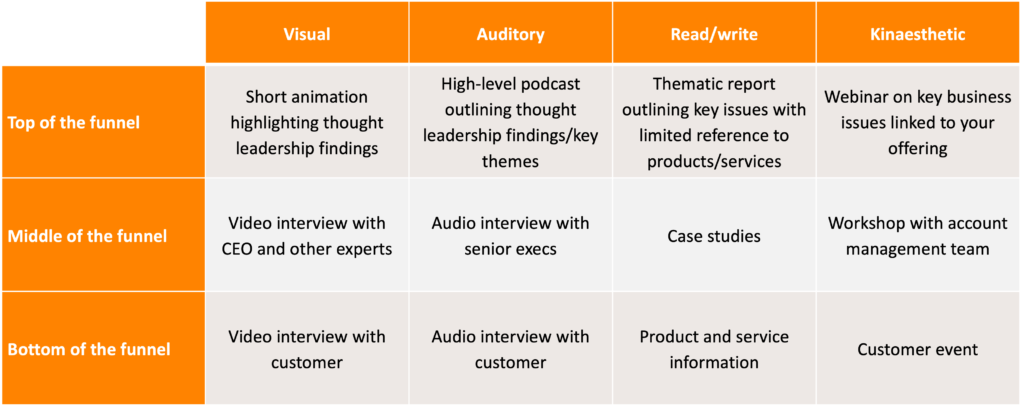Think VARK: Why your thought leadership should appeal to four different learning styles
Rob Mitchell
Marketers now know that most B2B audiences don’t just want a long-form PDF report. Every individual has distinct needs, and we all respond to content differently. Here, FT Longitude CEO Rob Mitchell explains why marketers need to create campaigns that cater for each of the four ways we learn.
Teachers know all about different learning styles and preferences. They understand that some students absorb information if it’s written down, and others learn more effectively when they listen. In the classroom, one size does not fit all. Now marketers are realising that it’s the same for thought leadership, and educators could show them a way to respond.
Step forward, Neil Fleming and Colleen Mills. The academics and teacher trainers from New Zealand have spent their careers helping educators to develop the best methods to communicate with their students. Instead of trying to tell teachers the best way to communicate with every student, they say, it’s better to help students identify the learning methods that work best for them.
So they developed a simple questionnaire called the VARK Inventory, which categorises four different ‘sensory modalities’, or preferences, for learning:
- Visual. You process information more easily if you can see it. You have a strong preference for charts, graphs, flow charts and diagrams.
- Aural. You absorb information best by listening to lectures, presentations and audio recordings.
- Read/write. You like the written word and tend to take a lot of notes.
- Kinaesthetic. You absorb information through experience and practice, and prefer information that has a practical application.
VARK comes to thought leadership
The VARK Inventory has been very influential in education — particularly in adult settings where learning tends to be more self-directed. But we also think it’s important for content and thought leadership, and we’re starting to see a significant shift in how content campaigns are constructed.
In the past, there was a heavy emphasis on long-form reports. These are great for those of us with a read/write preference, but are not much use for those of us who lean towards aural or visual. Instead, we recommend that marketers vary their formats, and consider VARK when they plan the content in their campaigns.
So what does that mean in practice? And what content is best suited to each of the VARK categories?
- Visual
Infographics, animations, data visualisation - Aural
Podcasts, audio interviews - Read/write
Long-form reports, short-form content, written opinion pieces, case studies - Kinaesthetic
Webinars, client events, conferences, workshops
More formats speak to more people
Include a range of these content formats in your campaign, and your brand is more likely to engage your audience. If you limit your thought leadership campaign to, say, one PDF report, you will automatically exclude the large proportion of your audience that prefers other learning styles.
Only 4% of respondents have a strong preference for a read/write style of content
This could be a huge mistake. Only about a third of the 237,000 respondents to the VARK questionnaire in 2020 have a preference for a single mode of learning, and just 4% have a strong preference for read/write only.
Two-thirds of people who responded to the questionnaire are multimodal, which means they have a preference for more than one style of learning. And among this group, the most common is VARK Type 2, who make up 25% of the population. They are not satisfied until they have had input from content in all of their preferred modes. In other words, they need to see content in multiple formats in order to learn effectively.
Your content plan needs two dimensions
But getting content formats right is only one step. Companies also need to think about how the formats come together to create a seamless audience journey.
Marketers need to remember that individuals are at different stages of their relationship with their brand. Some may know very little about them, but others will be much further advanced and have a good understanding of their products, services and message.
So think about your content in two dimensions:
- Format/learning style
- Extent of experience and knowledge of your brand/stage of the buyer journey.
Ideally, you will produce a content plan that looks something like this:

Appeal to different learning styles, and your content will be much more likely to succeed — especially when you add what you know about your audience’s varied levels of brand engagement and knowledge. Fleming and Mills may have started in education, but VARK could also be invaluable to B2B marketers: today’s best campaigns should work for each of the four different types of learner.
Speak to the team
We’ll help you to navigate and overcome any challenges you currently face and learn how to get more out of your content.
Book a meeting
About the author: Rob Mitchell
Rob is our CEO and co-founder and leads FT Longitude’s strategic planning and sets the overall vision and priorities for the business. He manages the board-level relationship with FT Longitude’s parent company, the Financial Times group, and also oversees FT Longitude’s finances, people management and administration.
Prior to co-founding FT Longitude in 2011, Rob was an independent writer and editor. Between 2007 and 2010, he was a managing editor at the Economist Intelligence Unit and prior to that he was an editor at the Financial Times, where he was responsible for the newspaper’s sponsored reports, including the Mastering Management series.
 |
Tel:
+44 (0)20 7873 4770
|
Tel:
+44 (0)20 7873 4770



